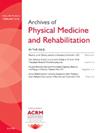增强中风后手部运动恢复:机器人与传统镜像疗法的比较研究。
IF 3.7
2区 医学
Q1 REHABILITATION
Archives of physical medicine and rehabilitation
Pub Date : 2025-08-01
DOI:10.1016/j.apmr.2024.11.008
引用次数: 0
摘要
目的:本研究旨在评价机械外骨骼手(RMT)联合镜像疗法(MT)对脑卒中后患者手部康复的治疗效果,并与传统的镜像疗法进行比较。设计:随机对照试验。时间设定:2023年11月至2024年2月。参与者:40名中风后受试者。干预措施:参与者分为两组:一组接受机器人外骨骼手部治疗联合镜像治疗(RMT+MT),另一组接受常规镜像治疗(MT)。干预时间为6周。主要观察指标:采用Fugl-Meyer上肢功能评估(FMA-UE) -手部运动域评估手部运动功能能力,采用九孔Peg测试(NHPT)评估手指灵巧性。结果:RMT组手部运动功能显著改善,FMA-UE-Hand motor Domain评分中位数从6分增加到14分(p = 0.000)。RMT组的手指灵巧性也有显著改善(p = 0.000)。传统MT组在FMA-UE-Hand Motor Domain (p = 0.001)和NHPT (p = 0.000)均有显著改善。然而,RMT组取得了更大的改善,两组在FMA-UE-Hand Motor Domain (p = 0.038)和NHPT (p = 0.026)得分上均有显著差异。结论:RMT在脑卒中后康复患者手部运动技能的恢复和手指灵巧性的改善方面明显优于传统的RMT。本文章由计算机程序翻译,如有差异,请以英文原文为准。
Enhancing Hand Motor Recovery Poststroke: A Comparative Study of Robotic vs Conventional Mirror Therapy
Objective
To evaluate the therapeutic effect of using a robotic exoskeletal hand (RMT) combined with mirror therapy (MT) in hand rehabilitation for poststroke patients, compared to conventional MT.
Design
Randomized controlled trial.
Setting
Physical Medicine and Rehabilitation Outpatient Clinic.
Participants
Forty poststroke subjects.
Interventions
Participants were divided into 2 groups: one received robotic exoskeletal hand therapy combined with mirror therapy (RMT+MT), and the other received conventional MT. The intervention lasted for 6 weeks.
Main Outcome Measures
Hand motor function abilities were assessed using the Fugl-Meyer Assessment for Upper Extremities (FMA-UE)—Hand Motor Domain, and finger dexterity was evaluated with the Nine-Hole Peg Test (NHPT).
Results
The RMT group showed significant improvement in hand motor function, with a median FMA-UE-Hand Motor Domain score increasing from 6 to 14 (P=.000). Finger dexterity also improved significantly in the RMT group (P=.000). The conventional MT group demonstrated significant improvements in both the FMA-UE-Hand Motor Domain (P=.001) and NHPT (P=.000). However, the RMT group achieved greater improvements, with significant differences between the 2 groups in both FMA-UE-Hand Motor Domain (P=.038) and NHPT (P=.026) scores.
Conclusions
RMT is significantly more effective in restoring hand motor skills and improving finger dexterity in patients with poststroke rehabilitation compared to conventional MT.
求助全文
通过发布文献求助,成功后即可免费获取论文全文。
去求助
来源期刊
CiteScore
6.20
自引率
4.70%
发文量
495
审稿时长
38 days
期刊介绍:
The Archives of Physical Medicine and Rehabilitation publishes original, peer-reviewed research and clinical reports on important trends and developments in physical medicine and rehabilitation and related fields. This international journal brings researchers and clinicians authoritative information on the therapeutic utilization of physical, behavioral and pharmaceutical agents in providing comprehensive care for individuals with chronic illness and disabilities.
Archives began publication in 1920, publishes monthly, and is the official journal of the American Congress of Rehabilitation Medicine. Its papers are cited more often than any other rehabilitation journal.

 求助内容:
求助内容: 应助结果提醒方式:
应助结果提醒方式:


